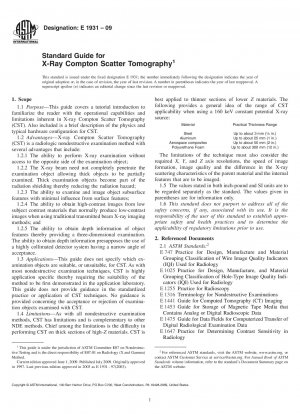ASTM E1931-09
Standard Guide for X-Ray Compton Scatter Tomography
- Standard No.
- ASTM E1931-09
- Release Date
- 2009
- Published By
- American Society for Testing and Materials (ASTM)
- Status
- Replace By
- ASTM E1931-16
- Latest
- ASTM E1931-16(2022)
- Scope
Principal Advantage of Compton Scatter Tomography8212;The principal advantage of CST is the ability to perform three-dimensional X-ray examination without the requirement for access to the back side of the examination object. CST offers the possibility to perform X-ray examination that is not possible by any other method. The CST sub-surface slice image is minimally affected by examination object features outside the plane of examination. The result is a radioscopic image that contains information primarily from the slice plane. Scattered radiation limits image quality in normal radiographic and radioscopic imaging. Scatter radiation does not have the same detrimental effect upon CST because scatter radiation is used to form the image. In fact, the more radiation the examination object scatters, the better the CST result. Low subject contrast materials that cannot be imaged well by conventional radiographic and radioscopic means are often excellent candidates for CST. Very high contrast sensitivities and excellent spatial resolution are possible with CST tomography.
Limitations8212;As with any nondestructive testing method, CST has its limitations. The technique is useful on reasonably thick sections of low-density materials. While a 25 mm (1 in.) depth in aluminum or 50 mm (2 in.) in plastic is achievable, the examination depth is decreased dramatically as the material density increases. Proper image interpretation requires the use of standards and examination objects with known internal conditions or representative quality indicators (RQIs). The examination volume is typically small, on the order of a few cubic inches and may require a few minutes to image. Therefore, completely examining large structures with CST requires intensive re-positioning of the examination volume that can be time-consuming. As with other penetrating radiation methods, the radiation hazard must be properly addressed.
1.1 Purpose8212;This guide covers a tutorial introduction to familiarize the reader with the operational capabilities and limitations inherent in X-ray Compton Scatter Tomography (CST). Also included is a brief description of the physics and typical hardware configuration for CST.
1.2 Advantages8212;X-ray Compton Scatter Tomography (CST) is a radiologic nondestructive examination method with several advantages that include:
1.2.1 The ability to perform X-ray examination without access to the opposite side of the examination object;
1.2.2 The X-ray beam need not completely penetrate the examination object allowing thick objects to be partially examined. Thick examination objects become part of the radiation shielding thereby reducing the radiation hazard;
1.2.3 The ability to examine and image object subsurface features with minimal influence from surface features;
1.2.4 The ability to obtain high-contrast images from low subject contrast materials that normally produce low-contrast images when using traditional transmitted beam X-ray imaging methods; and
1.2.5 The ability to obtain depth information of object features thereby providing a three-dimensional examination. The ability to obtain depth information presupposes the use of a highly collimated detector system having a narrow angle of acceptance.
1.3 Applications8212;This guide does not specify which examination objects are suitable, or unsuitable, for CST. As with most nondestructive examination techniques, CST is highly application specific thereby requiring the suitability of the method to be first demonstrated in the application labor......
ASTM E1931-09 Referenced Document
- ASTM E1025 Standard Practice for Design, Manufacture, and Material Grouping Classification of Hole-Type Image Quality Indicators (IQI) Used for Radiology
- ASTM E1255 Standard Practice for Radioscopy
- ASTM E1316 Standard Terminology for Nondestructive Examinations
- ASTM E1441 Standard Guide for Computed Tomography (CT)
- ASTM E1453 Standard Guide for Storage of Media That Contains Analog or Digital Radioscopic Data
- ASTM E1475 Standard Guide for Data Fields for Computerized Transfer of Digital Radiological Test Data
- ASTM E1647 Standard Practice for Determining Contrast Sensitivity in Radioscopy
- ASTM E747 Standard Practice for Design, Manufacture and Material Grouping Classification of Wire Image Quality Indicators (IQI) Used for Radiology
ASTM E1931-09 history
- 2022 ASTM E1931-16(2022) Standard Guide for Non-computed X-Ray Compton Scatter Tomography
- 2016 ASTM E1931-16 Standard Guide for Non-computed X-Ray Compton Scatter Tomography
- 2009 ASTM E1931-09 Standard Guide for X-Ray Compton Scatter Tomography
- 1997 ASTM E1931-97(2003) Standard Guide for X-Ray Compton Scatter Tomography
- 1997 ASTM E1931-97 Standard Guide for X-Ray Compton Scatter Tomography
